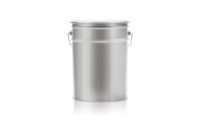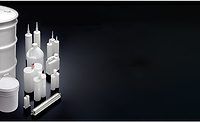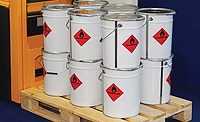Container Labeling for Adhesives and Sealants
Proper selection of label and labeler type enables the efficient application of labels on virtually every container shape used in the adhesives and sealants industry.

Within today’s diverse adhesive and sealants product segments, encompassing very different markets such as retail, architectural, industrial, and aerospace applications, all buyers and end users depend on clearly labeled containers. Since different label formats are available for a multitude of container geometries, it is helpful to understand the basics of labeling choices for future projects.
Container labeling serves multiple functions. Usage and safety instructions ensure customer satisfaction, while dosing and mixing information provides confidence in product performance. In addition, lot number codes support product tracking protocols. Labeling also delivers attractive aesthetics, which are especially important in the retail adhesives and sealants marketplace.
Container Variety
First in defining a labeler project is to review container options. Adhesives and sealants are packaged in a variety of containers, differentiated by shape and material. Although round container shapes are still most prominent, examples of common non-round containers include two-part cartridge, F-style, jug, and tapered pail. Container shape is mostly determined by the dispensing method from the container.
Steel and plastics (HDPE, PVC, and PET) comprise the most common container materials. The nature of the product chemistry generally dictates the appropriate material to use to maintain product stability in the container. Metal containers are usually round or square. In environments at risk of explosion, metal containers are required.
Label Review
Next in labeling project definition is to determine label and adhesive type. Label types are intrinsically tied to the type of adhesive used to apply the label to the container. Therefore, labels are often described by their adhesive. The three most common label types are hot melt, cold glue (or wet glue), and pressure sensitive.
Hot-melt and cold-glue labels are known as cut-and-stack labels. These labels are cut individually and arranged in a bundle like a deck of cards, typically with 1,000 labels in a stack. During the labeling process, cut-and-stack labels require the labeler to apply either the hot-melt or cold-glue adhesive to the label to complete the application process. Cut labels are generally inexpensive, and cut-and-stack labelers lend themselves to both high-speed and frequent changeover operations.
Hot-melt labelers require a full/overlapping wrap label and use much less adhesive than cold-glue labelers. Most hot-melt labelers are used on round containers, although F-style containers use hot-melt labelers as well. On the other hand, cold-glue labelers apply either spot labels or full-wrap labels and more easily accommodate non-round container shapes such as ovals and tapered pails. When it comes to explosion-proof, hazard-rated Class 1, Division 1 environments, cold-glue labelers are usually called for.
Another label option for hot-melt label application is roll-fed labeling, where labels are received on a roll. During operation, a roll of labels is mounted on the labeler. As containers move through the labeler, labels are cut to length and applied to the containers (typically round). The label material for roll-fed hot-melt labels is typically lightweight and thus inexpensive. Operationally, due to longer changeover times, hot-melt roll-fed labelers are installed on production lines where changeover is infrequent. Aerosol containers commonly use roll-fed hot-melt labels.
Another popular label format is the pressure-sensitive label. Pressure-sensitive labels use full-surface gluing, with labels adhered to a backing paper matrix. Pressure-sensitive labels arrive in rolls. During operation, a label roll is placed on the labeler. As containers move through the labeler, pressure-sensitive labels are peeled off the backing paper and applied and pressed securely onto the containers.
Pressure-sensitive labels are used for virtually every container shape in the adhesives and sealants industry. Some containers, such as two-part epoxy cartridges and adhesive sticks, lend themselves especially well to pressure-sensitive labels. In addition, pressure-sensitive labels provide desirable aesthetics for retail purposes. The labelers accommodate short runs and frequent changeovers. Pressure-sensitive labels are typically more expensive than cut labels.
A growing label format within the chemical industry is multi-page labels (i.e., booklet labels and expanded-content labels). Multi-page labels allow additional space for usage, mixing, and safety instruction in several languages. Label converters make multi-page labels for pressure-sensitive and roll-fed hot-melt formats.
Automatic Labelers
Automatic labelers can reliably apply labels to virtually every container shape used in the adhesives and sealants industry. Labelers are typically described by the adhesive used, such as hot-melt labeler, cold-glue labeler, and pressure-sensitive labeler.
Labeler capabilities are widely diverse in design, as determined mostly by container shape, speed, and the number of labels applied per container. A pressure-sensitive labeler designed to substitute for hand labeling would be small and inexpensive. On the other end of the spectrum, a hot-melt labeler to apply full-wrap labels to F-style gallons would be large and require a more substantial capital investment. Similarly, containers requiring a single label would run on a simpler labeler than one designed to apply two or more labels per container.
For more information, contact the author at (920) 889-8595 or dokeefe@langguth.ca, or visit www.langguth-america.com.
Looking for a reprint of this article?
From high-res PDFs to custom plaques, order your copy today!






